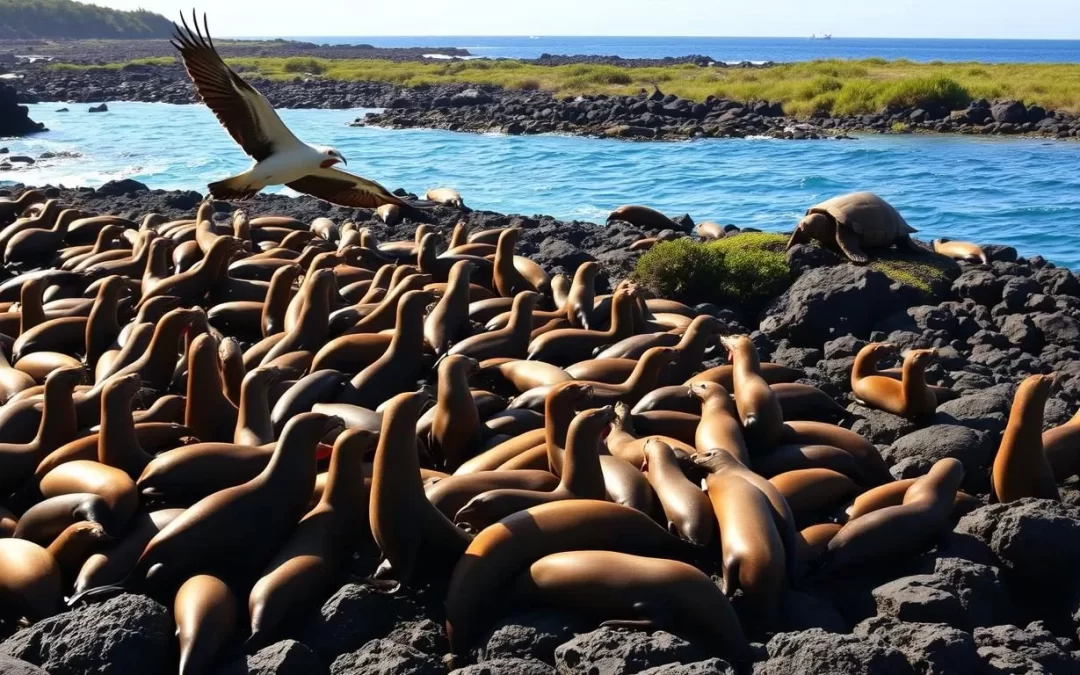
Galápagos Islands, Ecuador: Best Things to Do – Top Picks
Imagine stepping into a world where wildlife roams free and unafraid, a place that inspired one of the most groundbreaking theories in science. Located about 620 miles off the coast of Ecuador, this archipelago is a haven for nature lovers and adventure seekers alike.
As you explore the islands, you’ll encounter an incredible array of animals, from giant tortoises to marine iguanas, and blue-footed boobies. The unique experience of being up close with these creatures in their natural habitats is truly unforgettable.
With its diverse landscapes, including volcanic terrains and pristine beaches, the Galápagos offers a wide range of activities, from snorkeling with sea turtles to hiking through volcanic landscapes. Get ready to immerse yourself in one of the world’s most unique wildlife experiences.
Discovering the Enchanted Islands
The Galápagos Islands, with their rich biodiversity and untouched landscapes, offer an unparalleled opportunity to explore one of the world’s most pristine ecosystems. As you explore this unique archipelago, you’ll discover a place where nature has remained largely unspoiled.
A Natural Paradise 600 Miles Off Ecuador’s Coast
Located approximately 600 miles west of Ecuador’s mainland, the Galápagos Islands are a haven for wildlife enthusiasts and scientists. The archipelago’s remote location has allowed its species to evolve in isolation, creating a living laboratory of evolutionary processes.
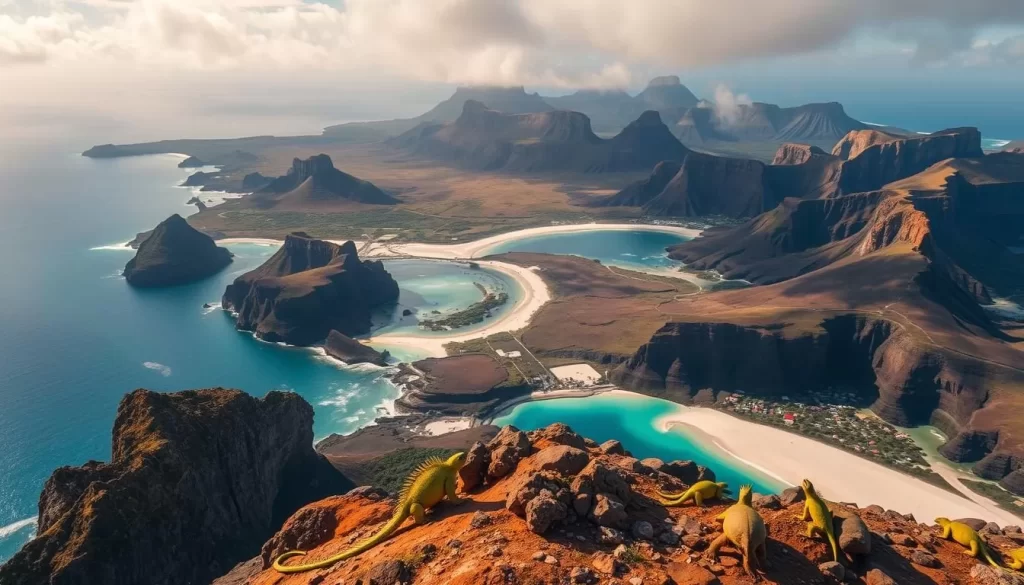
The Galápagos archipelago emerged from volcanic activity millions of years ago, resulting in a unique natural environment. This “Enchanted Islands” remained largely untouched by humans until their discovery in 1535. It was during Charles Darwin’s 19-day visit in 1835 that observations were made, later forming the foundation of his revolutionary theory of evolution by natural selection.
Understanding the Significance of the Galápagos
The Galápagos is recognized as both a UNESCO World Heritage site and a biosphere reserve, highlighting its global significance. The islands’ isolation has resulted in approximately 80% of land birds, 97% of reptiles and land mammals, and 30% of plants being found nowhere else on Earth. This makes the Galápagos a place of immense scientific importance and a paradise for conservation efforts, closely linked to the legacy of Charles Darwin.
Today, visitors can experience the magic of the Galápagos, witnessing firsthand the incredible biodiversity that makes this archipelago so unique. The islands offer a chance to connect with nature in its purest form, making for an unforgettable experience.
When to Visit the Galápagos Islands
No matter when you visit, the Galápagos Islands promise an adventure like no other. The islands are a unique destination that can be enjoyed year-round, with each season offering distinct experiences and opportunities to explore the rich biodiversity.
Dry Season (June-December): Cooler Weather and Active Marine Life
During the dry season, the cooler temperatures and nutrient-rich waters attract a wide variety of marine life, making it an ideal time for snorkeling and diving. The Humboldt Current brings colder water (65-75°F), creating perfect conditions for observing active marine species.
Wet Season (January-May): Warmer Waters and Breeding Wildlife
The wet season brings warmer air temperatures and sea temperatures (75-85°F), ideal for swimming without wetsuits. This period coincides with the breeding season for many species, offering opportunities to witness unique behaviors such as the courtship displays of blue-footed boobies and the nesting of sea turtles.
- The dry season is ideal for snorkeling and diving due to abundant marine life.
- The wet season offers warmer waters and the chance to see breeding wildlife.

How to Get to the Galápagos Islands
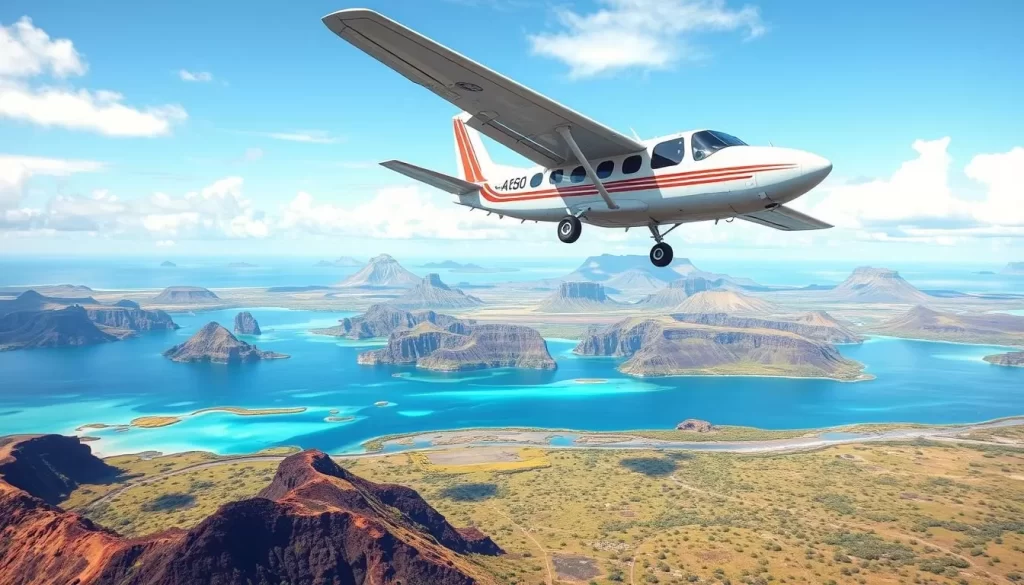
The journey to the Galápagos Islands requires careful planning, starting with flights from mainland Ecuador. To begin your trip, you’ll need to fly into either Quito or Guayaquil, both of which receive multiple international flights daily from major U.S. cities.
Flying from Quito or Guayaquil
Quito offers a rich cultural experience with its UNESCO-listed colonial center, but its high altitude may pose a challenge for some travelers. On the other hand, Guayaquil is at sea level, making it a more accessible option, though it has fewer tourist attractions. From either city, you’ll take a domestic flight to one of the two airports in the Galápagos: Seymour Airport on Baltra Island or San Cristóbal Airport.
Navigating Between Islands
Once you arrive in the Galápagos, you can travel between islands by speedboat or smaller planes. The journey between the main islands typically takes 2-3 hours by boat. Water taxis are also available to transport you between ports and anchored boats, making your way around the island convenient.
Land-Based vs. Cruise Experiences
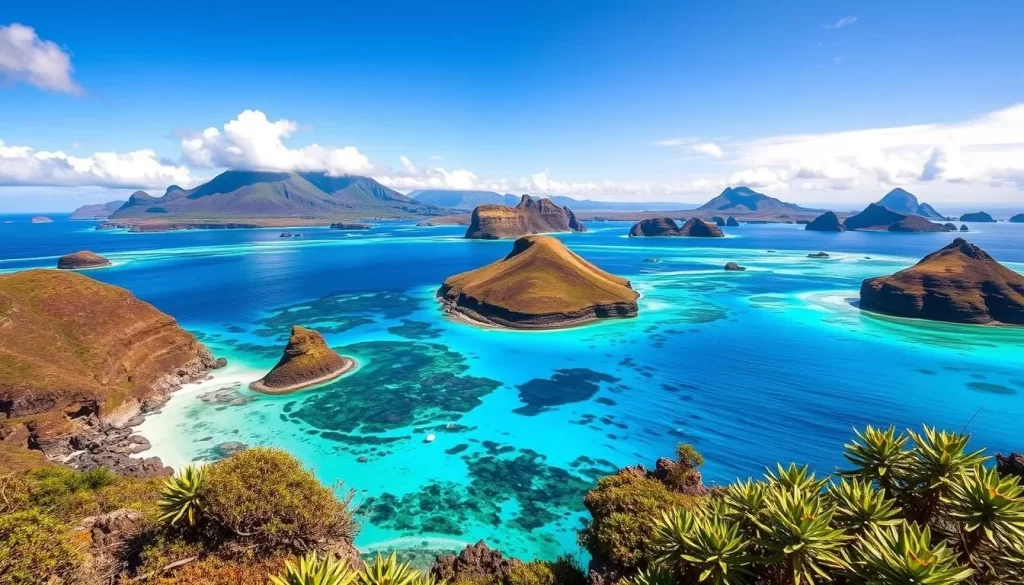
When planning a trip to the Galápagos Islands, one of the most crucial decisions you’ll make is whether to stay on land or opt for a cruise experience. Both options offer unique advantages, and the choice largely depends on your travel preferences, budget, and what you hope to achieve during your visit.
Benefits of Staying on the Islands
Staying on the islands provides you with the flexibility to create your own schedule, enjoy local cuisine, and experience the culture of the inhabited islands. You can choose from a variety of accommodations on islands like Santa Cruz and San Cristóbal, ranging from budget-friendly options to luxury hotels. Day tours to nearby islands and attractions are easily arranged, though you may spend more time traveling between destinations.
Advantages of Live-Aboard Boats
On the other hand, live-aboard cruises offer an efficient way to visit multiple islands without the hassle of constant packing and unpacking. You’ll have access to remote areas that are less frequented by day-trippers, and expert naturalist guides will enhance your understanding and appreciation of the wildlife and ecosystems. Cruises typically follow set itineraries that are designed to minimize environmental impact while maximizing your exposure to the Galápagos’ unique biodiversity.
Ultimately, your choice between a land-based stay and a cruise will depend on your priorities. If you value flexibility and immersion in local culture, staying on the islands might be the best choice. However, if you’re looking for a comprehensive wildlife experience with access to remote areas, a live-aboard cruise could be the way to go.
Exploring Bartolome Island’s Stunning Landscapes
![]()
If you’re looking for a unique island experience, Bartolome Island in the Galapagos is a top choice, with its dramatic volcanic landscapes and rich marine life. This small island is a must-visit for any traveler seeking adventure and breathtaking views.
Hiking to the Summit
The 375-foot summit hike is a highlight of any visit to Bartolome Island. The trail takes you through a moon-like volcanic landscape, featuring a wooden staircase and boardwalk that lead to the top. From there, you’ll be rewarded with breathtaking panoramic views of the surrounding islands and turquoise waters.
Snorkeling Around Pinnacle Rock
Bartolome Island is also renowned for its exceptional snorkeling opportunities. The crystal-clear waters around Pinnacle Rock are home to a diverse array of marine life, including playful sea lions, tropical fish, and the occasional penguin. Snorkeling or diving here provides an unforgettable experience, with close encounters with the island’s unique wildlife.
Bartolome Island offers one of the most photographed landscapes in the Galapagos, featuring the iconic Pinnacle Rock formation. The island is only accessible via organized tours from Santa Cruz or as part of a cruise itinerary. Due to its popularity and visitor restrictions, booking your tour well in advance is essential.
Whether you’re hiking to the summit or snorkeling around Pinnacle Rock, Bartolome Island promises an unforgettable experience in the Galapagos. With its stunning landscapes and rich marine life, this island is sure to leave a lasting impression on any traveler.
Encountering Giant Tortoises in Their Natural Habitat
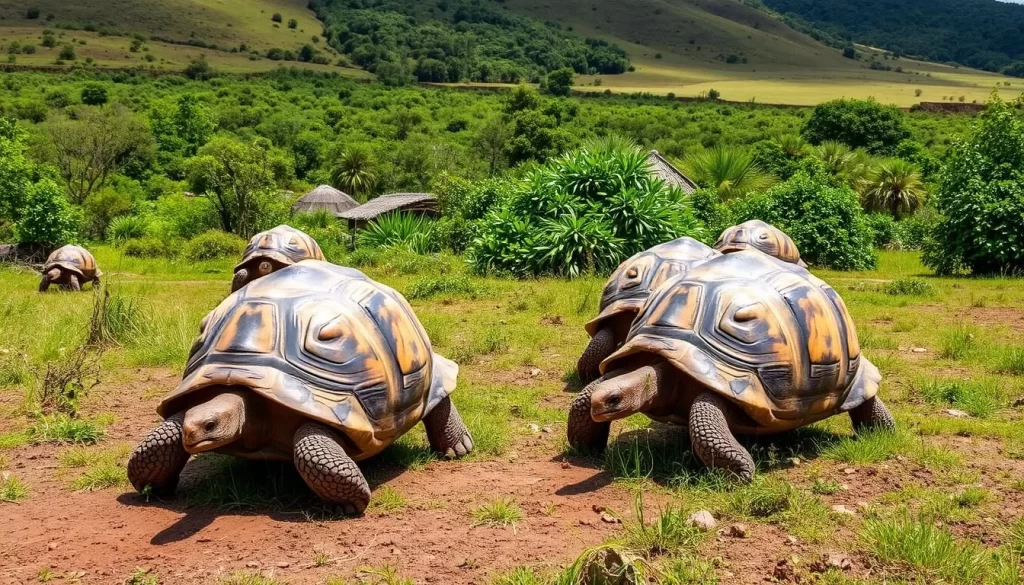
You can witness giant tortoises in their natural environment on the Galápagos Islands, particularly on Santa Cruz Island. The experience is both awe-inspiring and humbling, allowing you to connect with these ancient creatures in a unique setting.
Santa Cruz Island is home to several highland reserves where you can see giant tortoises. Two of the most notable reserves are Rancho Primicias and El Chato Tortoise Reserve.
Rancho Primicias on Santa Cruz Island
Rancho Primicias is a privately-owned sanctuary that offers a serene and peaceful atmosphere. Here, you can walk among dozens of giant tortoises as they graze in their natural habitat. The reserve also features open-air lava tunnels formed by ancient volcanic activity, adding a unique twist to your visit.
The lack of crowds at Rancho Primicias makes it feel like you have the place to yourself, allowing for a more intimate experience with the tortoises. You can snap photos as these gentle giants lumber around the lush green landscapes, creating unforgettable memories.
El Chato Tortoise Reserve
El Chato Tortoise Reserve is another popular destination on Santa Cruz Island. It features a larger property with multiple tortoise viewing areas and additional attractions like the twin sinkholes called Los Gemelos. While it may be more crowded than Rancho Primicias, El Chato offers a diverse experience with various wildlife and landscapes.
Most highland tours from Puerto Ayora include visits to these tortoise reserves along with other attractions for around $40-50 per person. This offers excellent value for one of the Galápagos’ most memorable wildlife encounters.
Encountering Galápagos giant tortoises is a moving experience, with these creatures living up to 150 years and weighing over 500 pounds. The opportunity to see them in their natural habitat is a highlight of any trip to the Galápagos Islands.
Galápagos Islands, Ecuador: Best Things to Do for Wildlife Enthusiasts
If you’re a wildlife enthusiast, the Galápagos Islands are a must-visit destination, teeming with incredible biodiversity. The archipelago is renowned for its unique and endemic species that can be observed in their natural habitats.
Spotting Blue-Footed Boobies on North Seymour
The Galápagos Islands are home to 50% of the world’s breeding pairs of blue-footed boobies, making this a prime location for observing these fascinating birds. North Seymour Island is particularly notable for its large colony of boobies, where you can witness their distinctive mating dance.
During the mating season, male blue-footed boobies proudly display their vibrant blue feet to attract females. This spectacle is a highlight for many visitors to the Galápagos island chain.
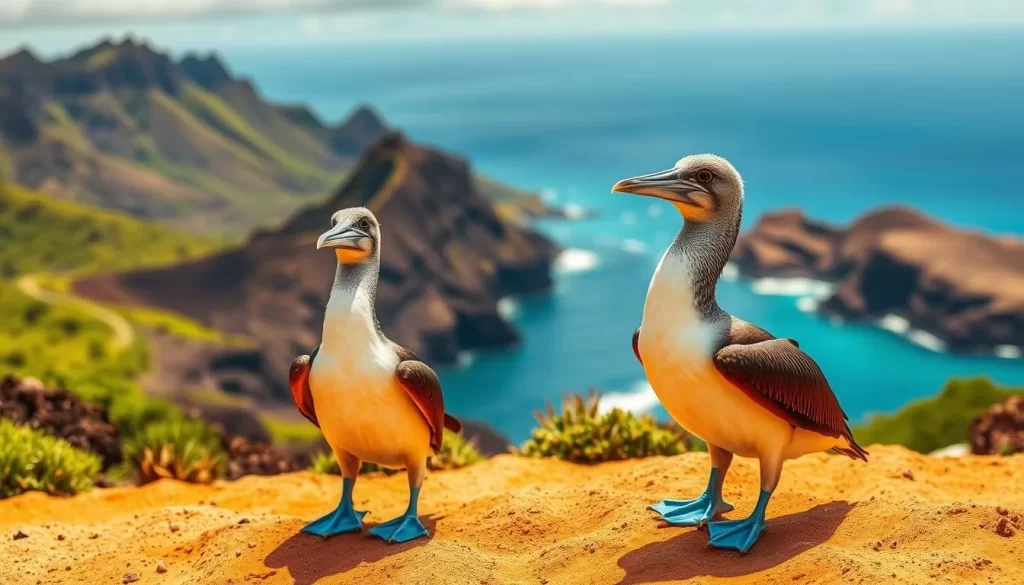
Observing Marine Iguanas Along Rocky Shores
Marine iguanas, the world’s only sea-going lizards, can be found basking in groups along the rocky shorelines of the Galápagos island. These creatures are a fascinating sight, occasionally sneezing out excess salt in a distinctive spray.
Watching Frigatebirds Display Their Red Pouches
The Galápagos island chain is also home to the largest colony of magnificent frigatebirds, where males inflate their bright red throat pouches during breeding season. This display is a spectacular sight for bird enthusiasts.
In addition to these iconic species, the Galápagos offers numerous other wildlife encounters, including observing Darwin’s finches, spotting Galápagos hawks, and watching the endemic flightless cormorants. The animals show little fear of humans, allowing for close-up observations of natural behaviors.
Best Beaches to Visit in the Galápagos
The Galápagos Islands boast an array of stunning beaches, each with its unique charm. Whether you’re looking for a secluded spot to relax or a family-friendly beach with plenty of activities, the Galápagos has something for everyone.
Tortuga Bay: Pristine White Sands and Wildlife
Tortuga Bay on Santa Cruz Island is a must-visit, offering a pristine white-sand beach accessible via a scenic 40-minute trail. Here, you can observe marine iguanas, sally lightfoot crabs, and occasionally sea lions lounging on the shore. While the main beach has strong currents, a short walk leads to a protected cove called Playa Mansa with calm, crystal-clear water perfect for swimming and kayaking.
Puerto Chino Beach: A Secluded Paradise
For a more secluded experience, head to Puerto Chino Beach on San Cristóbal Island. Located about 24 kilometers from Puerto Baquerizo Moreno, this beach offers excellent opportunities for swimming and snorkeling in calm waters where sea turtles are frequently spotted. The white sand beach is perfect for unwinding and relaxing in a peaceful setting.
Playa Mann: Family-Friendly and Accessible
Playa Mann, just a short walk from Puerto Baquerizo Moreno on San Cristóbal, is ideal for families. Its gentle waters, resident sea lion colony, and convenient location near restaurants and facilities make it a great choice.
| Beach Name | Location | Features |
|---|---|---|
| Tortuga Bay | Santa Cruz Island | Pristine white sands, marine iguanas, sea lions |
| Puerto Chino Beach | San Cristóbal Island | Secluded, calm waters, sea turtles |
| Playa Mann | San Cristóbal Island | Family-friendly, gentle waters, sea lion colony |

Underwater Adventures: Snorkeling and Diving Hotspots

With its unique biodiversity, the Galápagos Islands are a snorkeler’s paradise, offering encounters with species found nowhere else on Earth. The Galápagos Marine Reserve, one of the world’s largest protected ocean areas, provides extraordinary underwater experiences with visibility often exceeding 60 feet.
Swimming with Sea Lions, Turtles, and Rays
One of the most thrilling experiences in the Galápagos is swimming with playful sea lions. These curious mammals often approach snorkelers, performing underwater acrobatics and blowing bubbles just inches away. You’ll also have the opportunity to swim alongside graceful sea turtles and manta rays, making for an unforgettable experience.
Kicker Rock: A Premier Diving Location
Kicker Rock, also known as León Dormido, is a premier diving location near San Cristóbal Island. This dramatic split sea stack is home to an array of marine life, including hammerhead sharks, Galápagos sharks, eagle rays, and sea turtles. The site offers a unique opportunity to observe these species in their natural habitat.
Las Tintoreras: Shark Channels and Marine Life
Las Tintoreras, located near Isabela Island, offers a unique opportunity to observe white-tip reef sharks resting in shallow volcanic channels. You’ll also see marine iguanas swimming in the ocean, the only lizards in the world adapted for marine life. This site is a must-visit for anyone interested in exploring the Galápagos’ incredible marine biodiversity.
Hiking Volcanoes and Lava Formations
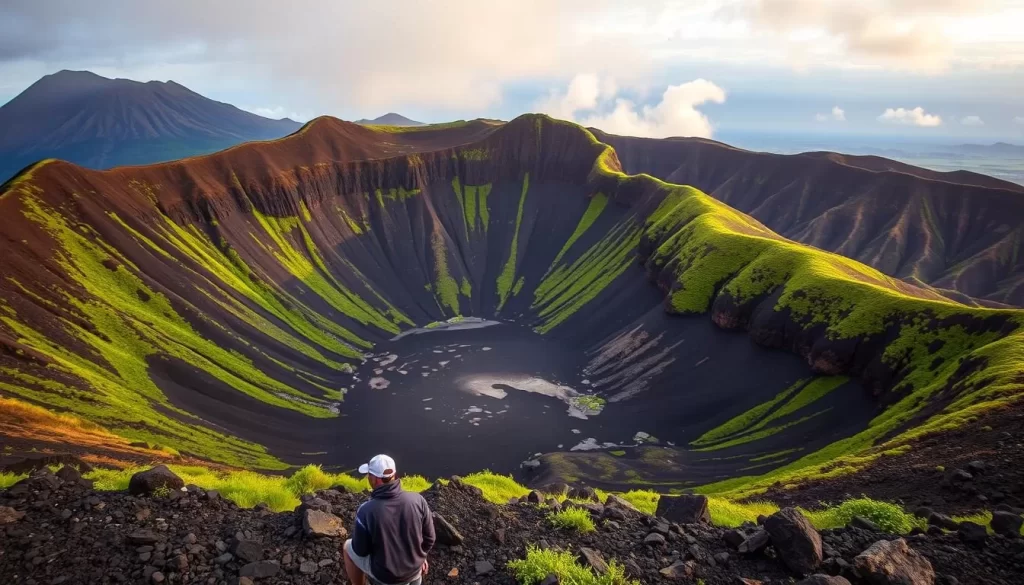
Hiking in the Galápagos is an unforgettable experience, with the Sierra Negra volcano on Isabela Island being a top destination. The Galápagos Islands are home to numerous volcanic formations, offering a unique opportunity to explore these natural wonders up close.
Sierra Negra Volcano on Isabela Island
The Sierra Negra volcano is one of the most impressive volcanic landscapes in the Galápagos. With its expansive crater, stretching nearly 10 kilometers in diameter, it’s a breathtaking sight that leaves hikers in awe. The guided 6-hour trek takes you through diverse ecosystems, from lush highlands to barren lava fields, where you can spot Galápagos hawks, Darwin’s finches, and occasionally giant tortoises.
The Wall of Tears: History and Nature Combined
On Isabela Island, you can also visit the Wall of Tears (El Muro de las Lágrimas), a somber historical site built by prisoners between 1945-1959. Now, it’s a place where nature and history blend together, accessible via a scenic bike ride from Puerto Villamil.
Los Gemelos (Twin Craters) on Santa Cruz
On Santa Cruz Island, Los Gemelos (Twin Craters) are massive sinkholes formed by collapsed lava chambers. Surrounded by scalesia forests, these unique formations are home to numerous bird species, including the elusive vermilion flycatcher. Exploring these volcanic hikes provides valuable insights into the geological forces that shaped the Galápagos archipelago.
With knowledgeable guides explaining the volcanic activity and unique geology of the area, you’ll gain a deeper understanding of these incredible landscapes. Whether you’re fascinated by volcanic landscapes or simply looking for adventure, hiking in the Galápagos is an experience you won’t forget.
Exploring the Charles Darwin Research Station

As the scientific heart of Galápagos conservation, the Charles Darwin Research Station plays a vital role in protecting the archipelago’s unique ecosystems. Located in Puerto Ayora on Santa Cruz Island, this research station is operated by the Charles Darwin Foundation and is dedicated to preserving the Galápagos ecosystem through scientific research and complementary action.
Learning About Conservation Efforts
Visitors can explore interactive exhibits that explain the islands’ formation, unique species, and the groundbreaking work that continues Charles Darwin‘s legacy of scientific discovery in the Galápagos. The research station highlights current conservation challenges facing the Galápagos, including invasive species management, sustainable tourism practices, and climate change impacts on this fragile ecosystem.
Visiting the Breeding Center
The station’s Giant Tortoise Breeding Center is a major attraction, showcasing a successful conservation program that has reared and released over 7,000 tortoises to their native islands. You can observe tortoises at every life stage, from tiny hatchlings to juvenile tortoises preparing for release into the wild, while learning about the distinct characteristics of subspecies from different islands.
Island Hopping: Must-Visit Islands Beyond the Main Three
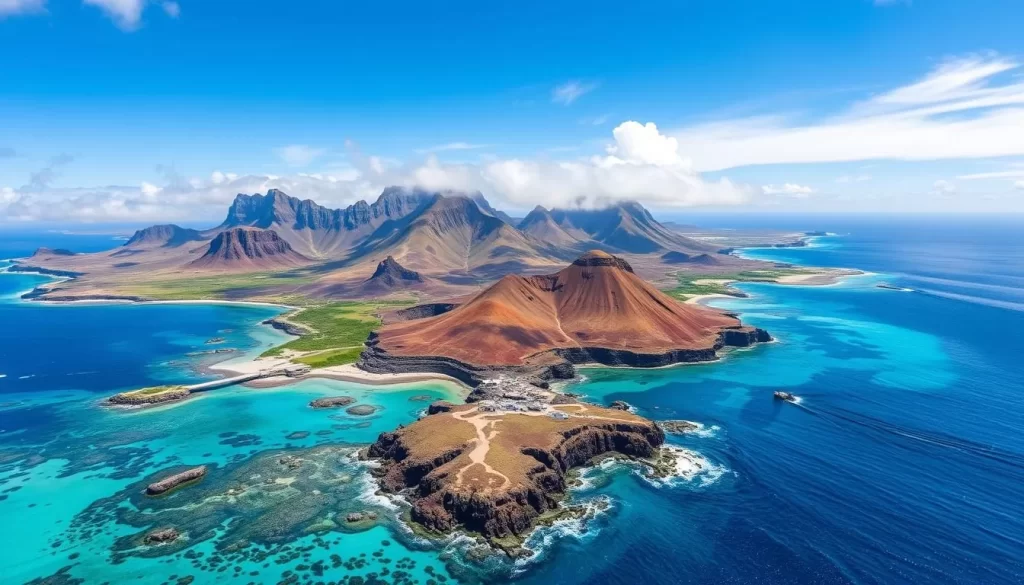
Island hopping in the Galápagos reveals a treasure trove of unique landscapes and wildlife. While many visitors explore the main islands, there are several other islands that offer unforgettable experiences.
Española Island: Home of the Waved Albatross
Española Island, also known as Hood Island, is the southernmost and oldest island in the Galápagos archipelago. It’s renowned for being the exclusive breeding site for the entire world’s population of waved albatrosses, observable from April to December. You can witness these magnificent birds, along with unique species like the Española mockingbird and the Española lava lizard.
Floreana Island: Human History and Post Office Bay
Floreana Island is a fascinating blend of human history and unique wildlife. One of its highlights is Post Office Bay, where visitors continue the 18th-century tradition of leaving unstamped postcards for other travelers to hand-deliver. The island is also home to a variety of species, including marine iguanas and sea lions.
Genovesa Island: Bird Paradise
Genovesa Island, or Tower Island, is known as “Bird Island” due to its massive colonies of seabirds. It’s home to the largest red-footed booby colony in the Galápagos, as well as great frigatebirds and the elusive short-eared owl. Visitors can observe these birds, including the iconic blue-footed boobies, in their natural habitat.
These remote islands are typically accessible via cruise itineraries, offering rewards of unique wildlife encounters and landscapes with fewer fellow travelers. By venturing beyond the main inhabited islands, you can experience the Galápagos in a more secluded and authentic way.
Local Experiences in Puerto Ayora and Puerto Baquerizo Moreno
Puerto Ayora and Puerto Baquerizo Moreno offer a glimpse into the unique island lifestyle of the Galápagos. These charming towns are not just gateways to the islands’ natural wonders but also hubs for experiencing the local culture and interacting with the incredible wildlife that roams freely.
Fish Markets and Local Wildlife Interactions
One of the highlights of visiting Puerto Ayora is the fish market, where you can witness the fascinating interaction between locals and wildlife. Sea lions and pelicans often attempt to steal fish from the market, creating an entertaining spectacle. This unique dynamic between humans and wildlife is a testament to the Galápagos’ extraordinary environment.
- Observe the daily interactions at the fish market in Puerto Ayora, where sea lions boldly try to steal scraps.
- Enjoy the waterfront promenades in both towns, where you can watch lions lounging on benches and boats.
- Take in the fresh seafood at local restaurants, savoring the flavors of the Galápagos.
Shopping and Dining in Town
Both Puerto Ayora and Puerto Baquerizo Moreno offer a range of shopping and dining experiences. You can find locally made crafts and souvenirs, many of which are created using sustainable materials that support conservation efforts. Take your time to chat with the locals, who have fascinating stories about island life and the challenges of conservation.
As you explore these towns, you’ll have the opportunity to enhance your experience by engaging with the community and learning about their unique way of life. From savoring local cuisine to purchasing handmade souvenirs, your visit to Puerto Ayora and Puerto Baquerizo Moreno will be filled with memorable moments.
Practical Tips for Your Galápagos Adventure
Before you embark on your journey to the Galápagos, here are some crucial tips to keep in mind. The Galápagos Islands offer a unique and unforgettable experience, but being prepared is key to making the most of yourtimethere.
What to Pack for Island Exploration
Packing the right gear is essential for a comfortable and enjoyable trip. Make sure to include water-resistant sunscreen (SPF50+), insect repellent, a wide-brimmed hat, quick-dry clothing, and sturdy walking shoes for volcanic terrain. A reusable water bottle is also a must to reduce plastic waste.
Understanding Park Fees and Regulations
The Galápagos National Park entrance fee is $100 per person, payable in cash upon arrival. You’ll also need to purchase a $20 transit card. It’s crucial to understand and respect the park’s rules to preserve the delicate ecosystem of the islands.
Responsible Tourism Practices
To protect the incredible animals and their habitats, maintain at least 6 feet of distance from wildlife, never touch or feed them, and stay on marked trails with your naturalist guide. Avoid removing any natural materials from the islands, and consider booking tours and accommodations in advance to manage visitor numbers effectively.
By following these guidelines, you’ll not only have a fantastic trip but also contribute to preserving the Galápagos for future generations. Planning your trip in the right way ensures a memorable experience.
- Come prepared with necessary items like sunscreen, appropriate clothing, and a camera.
- Understand the fees and regulations to avoid any inconvenience.
- Practice responsible tourism by respecting wildlife and their habitats.
This list of tips will help you navigate your Galápagos adventure with ease.
Conclusion: The Unforgettable Magic of the Galápagos
The Galápagos Islands, a place where the natural world unfolds in its purest form, leaves an indelible mark on every visitor. Standing amidst the islands’ breathtaking landscapes and encountering fearless wildlife creates a travel experience that resonates deeply.
Your journey through the Galápagos, whether by cruise or land-based exploration, will challenge your perceptions and foster a deeper connection with nature. The islands offer a rare glimpse into a world where humans are observers, not the dominant species. As you explore this unique place, you’ll find that the true magic lies not just in the activities on your list, but in the moments you take to appreciate the evolutionary story unfolding across these enchanted islands.
Many visitors find that their time in the Galápagos inspires a commitment to conservation and sustainable travel practices. As you plan your visit, remember to slow down and immerse yourself in the natural beauty surrounding you, creating an experience that will last a lifetime.
The above is subject to change.
Check back often to TRAVEL.COM for the latest travel tips and deals.